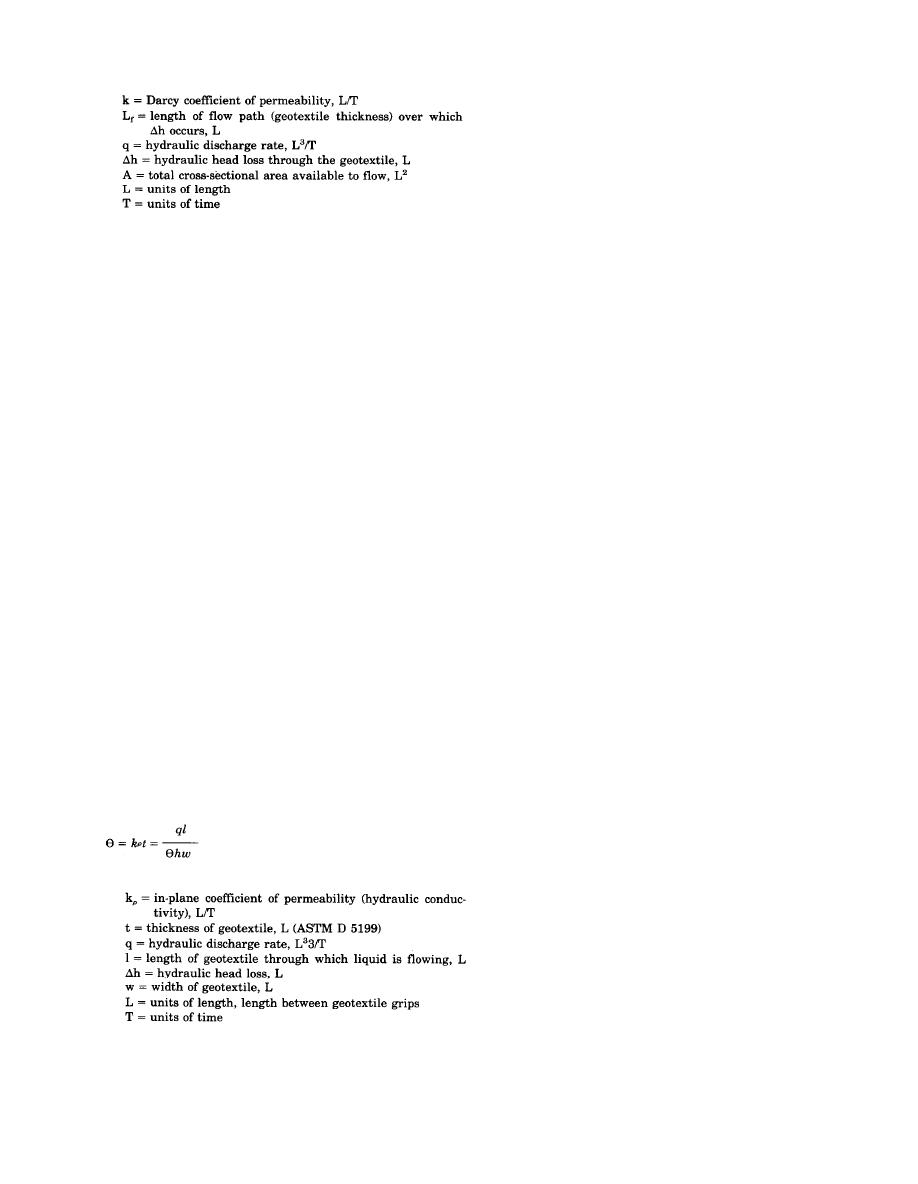
TM 5-818-8/AFJMAN 32-1030
where
gradients used, the normal pressure applied to the
product being tested, the potential for reduction of
transmissivity over time due to creep of the drain-
age material, and the possibility that intermittent
flow will result in only partial saturation of the
drainage material and reduced flow capacity.
ASTM D 4716 may be used for evaluating the
transmissivity of drainage materials.
The limitation of directly measuring the perme-
c. Limiting Criteria. Permeability criteria for
ability and permittivity of geotextiles is that
nonwoven geotextiles require that the permeabil-
Darcy's Law applies only as long as laminar flow
ity of the geotextile be at least five times the
exists. This is very difficult to achieve for geotex-
permeability of the surrounding soil. Permeability
tiles since the hydraulic heads required to assure
criteria for woven geotextiles are in terms of the
laminar flow are so small that they are difficult to
POA. When the protected soil has less than 0.5
accurately measure. Despite the fact that Darcy's
percent passing the No. 200 sieve, the POA should
equation does not apply for most measurements of
be equal to or greater than 10 percent. When the
permeability, the values obtained are considered
protected soil has more than 5 percent but less
useful as a relative measure of the permeabilities
than 85 percent passing the No. 200 sieve, the
and permittivities of various geotextiles. Values of
POA should be equal to or greater than 4 percent.
permeability reported in the literature, or obtained
3-6. Other Filter Considerations
from testing laboratories, should not be used with-
a. To prevent clogging or blinding of the geotex-
out first establishing the actual test conditions
tile, intimate contact between the soil and geotex-
used to determine the permeability value. ASTM
tile should be assured during construction. Voids
Method D 4491 should be used for establishing the
permeability and permittivity of geotextiles. The
between the soil and geotextile can expose the
permeability of some geotextiles decreases signifi-
geotextile to a slurry or muddy water mixture
during seepage. This condition promotes erosion of
cantly when compressed by surrounding soil or
soil behind the geotextile and clogging of the
rock. ASTM D 5493 can be used for measuring the
geotextile.
permeabilities of geotextiles under load.
b. In-plane Permeability. Thick nonwoven geo-
b. Very fine-grained noncohesive soils, such as
textiles and special products as prefabricated
rock flour, present a special problem, and design of
drainage panels and strip drains have substantial
drain installations in this type of soil should be
fluid flow capacity in their plane. Flow capacity in
based on tests with expected hydraulic conditions
a plane of a geotextile is best expressed indepen-
using the soil and candidate geotextiles.
dently of the material's thickness since the thick-
c. As a general rule slit-film geotextiles are
ness of various materials may differ considerably,
unacceptable for drainage applications. They may
while the ability to transmit fluid under a given
meet AOS criteria but generally have a very low
head and confining pressure is the property of
POA or permeability. The wide filament in many
interest. The property of in-plane flow capacity of
slit films is prone to move relative to the cross
a geotextile is termed "transmissivity," θ , and is
filaments during handling and thus change AOS
expressed as:
and POA.
d. The designer must consider that in certain
(eq 3-2)
areas an ochre formation may occur on the geotex-
tile. Ochre is an iron deposit usually a red or tan
gelatinous mass associated with bacterial slimes.
where
It can, under certain conditions, form on and in
subsurface drains. The designer may be able to
determine the potential for ochre formation by
reviewing local experience with highway, agricul-
tural, embankment, or other drains with local or
state agencies. If there is reasonable expectation
for ochre formation, use of geotextiles is discour-
aged since geotextiles may be more prone to clog.
Certain testing conditions must be considered if
Once ochre clogging occurs, removal from geotex-
meaningful values of transmissivity are to be
tiles is generally very difficult to impossible, since
acquired. These conditions include the hydraulic
chemicals or acids used for ochre removal can-
3-3


 Previous Page
Previous Page
